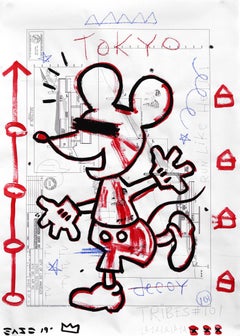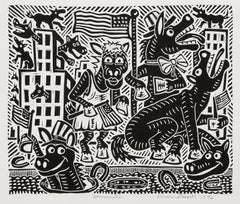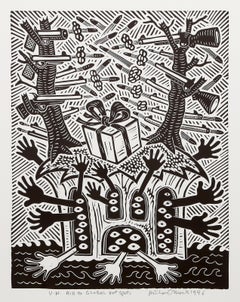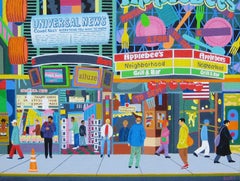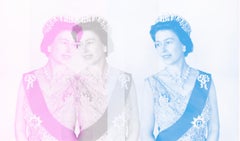Pop Art
Perhaps one of the most influential contemporary art movements, Pop art emerged in the 1950s. In stark contrast to traditional artistic practice, its practitioners drew on imagery from popular culture — comic books, advertising, product packaging and other commercial media — to create original Pop art paintings, prints and sculptures that celebrated ordinary life in the most literal way.
ORIGINS OF POP ART
- Started in Britain in the 1950s, flourished in 1960s-era America
- “This is Tomorrow,” at London's Whitechapel Gallery in 1956, was reportedly the first Pop art exhibition
- A reaction to postwar mass consumerism
- Transitioning away from Abstract Expressionism
- Informed by neo-Dada and artists such as Jasper Johns and Robert Rauschenberg; influenced postmodernism and Photorealism
CHARACTERISTICS OF POP ART
- Bold imagery
- Bright, vivid colors
- Straightforward concepts
- Engagement with popular culture
- Incorporation of everyday objects from advertisements, cartoons, comic books and other popular mass media
POP ARTISTS TO KNOW
- Richard Hamilton
- Andy Warhol
- Marta Minujín
- Claes Oldenburg
- Eduardo Paolozzi
- Rosalyn Drexler
- James Rosenquist
- Peter Blake
- Roy Lichtenstein
ORIGINAL POP ART ON 1STDIBS
The Pop art movement started in the United Kingdom as a reaction, both positive and critical, to the period’s consumerism. Its goal was to put popular culture on the same level as so-called high culture.
Richard Hamilton’s 1956 collage Just what is it that makes today’s homes so different, so appealing? is widely believed to have kickstarted this unconventional new style.
Pop art works are distinguished by their bold imagery, bright colors and seemingly commonplace subject matter. Practitioners sought to challenge the status quo, breaking with the perceived elitism of the previously dominant Abstract Expressionism and making statements about current events. Other key characteristics of Pop art include appropriation of imagery and techniques from popular and commercial culture; use of different media and formats; repetition in imagery and iconography; incorporation of mundane objects from advertisements, cartoons and other popular media; hard edges; and ironic and witty treatment of subject matter.
Although British artists launched the movement, they were soon overshadowed by their American counterparts. Pop art is perhaps most closely identified with American Pop artist Andy Warhol, whose clever appropriation of motifs and images helped to transform the artistic style into a lifestyle. Most of the best-known American artists associated with Pop art started in commercial art (Warhol made whimsical drawings as a hobby during his early years as a commercial illustrator), a background that helped them in merging high and popular culture.
Roy Lichtenstein was another prominent Pop artist that was active in the United States. Much like Warhol, Lichtenstein drew his subjects from print media, particularly comic strips, producing paintings and sculptures characterized by primary colors, bold outlines and halftone dots, elements appropriated from commercial printing. Recontextualizing a lowbrow image by importing it into a fine-art context was a trademark of his style. Neo-Pop artists like Jeff Koons and Takashi Murakami further blurred the line between art and popular culture.
Pop art rose to prominence largely through the work of a handful of men creating works that were unemotional and distanced — in other words, stereotypically masculine. However, there were many important female Pop artists, such as Rosalyn Drexler, whose significant contributions to the movement are recognized today. Best known for her work as a playwright and novelist, Drexler also created paintings and collages embodying Pop art themes and stylistic features.
Read more about the history of Pop art and the style’s famous artists, and browse the collection of original Pop art paintings, prints, photography and other works for sale on 1stDibs.
21st Century and Contemporary Pop Art
Pastel, Mixed Media, Acrylic
1990s Pop Art
Linocut
21st Century and Contemporary Pop Art
Wood
1990s Pop Art
Linocut
Artist Comments
People bustle past each other, filling the sidewalks of 42nd Street in New York City. On this sunny winter afternoon, storefronts dazzle with colorful advertisements, while theater marquee lights reflect off restaurant windows. The sounds of traffic mix with the lively beat of Spanish rock music from boom boxes, infusing the air with the vibrant pulse of urban life.
About the Artist
Artist Leroy Burt paints playful, offbeat landscapes and portraits based on his experiences living in Milwaukee, New York, Costa Rica, and currently Rochester, Minnesota. "I think of my paintings as short stories," he says. As a young child, Leroy faced a number of obstacles. His parents divorced when he was four years old and he was raised by his grandparents in a three-room shack without running water or electricity. Leroy worked hard to pull himself out of poverty. He studied graphic design and painting, which led to a 30-year career in graphic design - five years at WMVS, the PBS television station in Milwaukee, fifteen years at city hall in Milwaukee, and ten years at WNET, the PBS station in New York. In 2015, Leroy retired to focus his energy on painting. Today, he works from a tiny studio filled with half-finished paintings stacked against every wall. "There are photos and sketches for future paintings taped everywhere," says Leroy. "My windows are filled with orchids. There are books, films and music CDs in every corner. And the room is dominated by a black and silver Andy Warhol silkscreen...
21st Century and Contemporary Pop Art
Acrylic
2010s Pop Art
Color, Archival Pigment
Early 2000s Pop Art
Acrylic, Foam Board
Early 2000s Pop Art
Screen
2010s Pop Art
Resin
2010s Pop Art
Glass, Resin, Mixed Media
2010s Pop Art
Photographic Paper, C Print, Color, Silver Gelatin
21st Century and Contemporary Pop Art
Resin
21st Century and Contemporary Pop Art
Giclée
2010s Pop Art
Metal
2010s Pop Art
Photographic Paper, C Print, Color, Silver Gelatin
21st Century and Contemporary Pop Art
Paper, Mixed Media, Spray Paint, Acrylic, Oil Pastel, Graphite
1980s Pop Art
Photographic Paper, Color
2010s Pop Art
Giclée, Varnish
2010s Pop Art
Resin
Early 2000s Pop Art
Lithograph
1980s Pop Art
Offset, Lithograph
2010s Pop Art
Mixed Media, Oil, Acrylic, Panel
1950s Pop Art
Paint
2010s Pop Art
Canvas, Color
1990s Pop Art
Paper, Offset
2010s Pop Art
Resin
2010s Pop Art
Resin, Vinyl
1990s Pop Art
Archival Ink, Archival Paper, Lithograph, Offset
2010s Pop Art
Wood, Lithograph, Offset
21st Century and Contemporary Pop Art
Charcoal, Ink, Mixed Media, Acrylic, Wood Panel, Archival Paper
Artist Comments
A whimsical rural scene unfolds as a Holstein named Ella from Elmore County, Alabama, stands proudly on the bed of an old pickup truck. It drives beneath a vast sky filled with voluminous clouds. The cow, who earned second place at the annual Dairy Cattle Show last...
21st Century and Contemporary Pop Art
Mixed Media
1960s Pop Art
Lithograph, Offset
1970s Pop Art
Silver Gelatin
21st Century and Contemporary Pop Art
Lithograph
2010s Pop Art
Canvas, Oil
21st Century and Contemporary Pop Art
Photographic Paper, C Print, Color, Silver Gelatin
1970s Pop Art
Screen
21st Century and Contemporary Pop Art
Gold Leaf
1980s Pop Art
Offset
1980s Pop Art
Screen
2010s Pop Art
Resin, Spray Paint, Acrylic, Archival Paper
1980s Pop Art
Offset
2010s Pop Art
Canvas, Color
2010s Pop Art
Giclée, Lithograph, Digital Pigment
21st Century and Contemporary Pop Art
Pastel, Mixed Media, Acrylic
2010s Pop Art
Resin
1990s Pop Art
Screen
2010s Pop Art
Offset
1970s Pop Art
Silver Gelatin
2010s Pop Art
Varnish, Lithograph, Offset
1980s Pop Art
Lithograph, Offset
1990s Pop Art
Foil
1970s Pop Art
Screen
1980s Pop Art
Silver Gelatin
2010s Pop Art
Wood, Acrylic
2010s Pop Art
Porcelain
Late 20th Century Pop Art
Screen
1980s Pop Art
Lithograph, Offset
1990s Pop Art
Screen
1960s Pop Art
Paper, Lithograph, Offset, Screen
